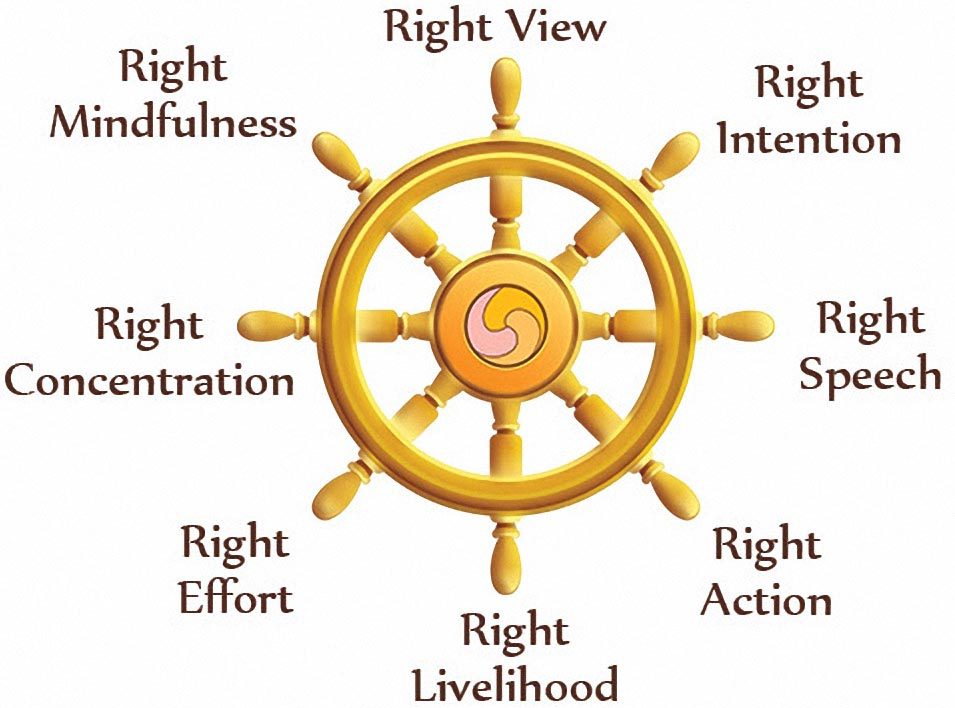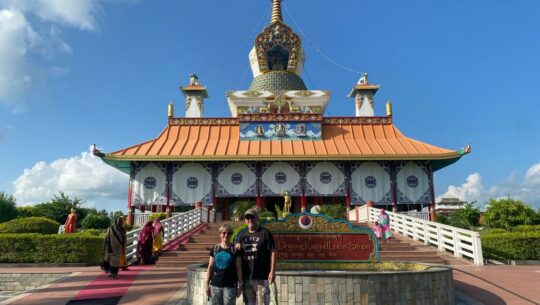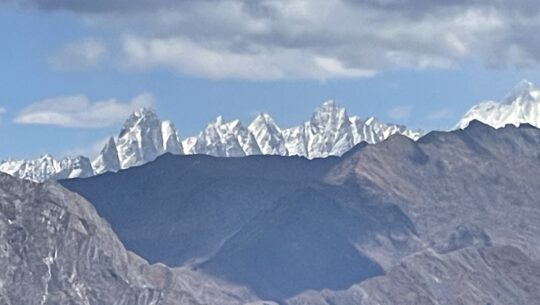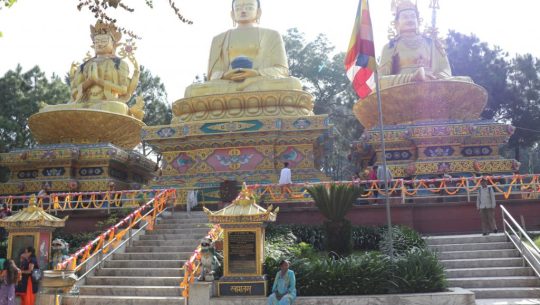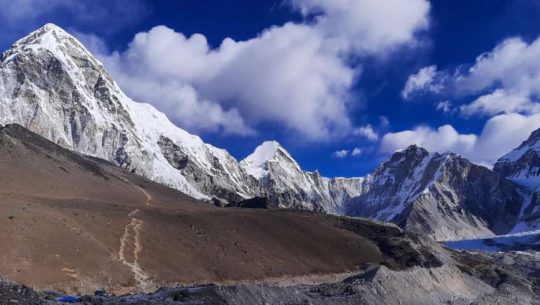Explore the intersection of modern civilization and Shakyamuni Buddha’s teachings, examining how ancient Buddhist principles can address contemporary societal challenges, foster inner peace, and promote sustainable living in today’s fast-paced world. Discover the relevance of mindfulness, compassion, and ethical living in navigating modern life’s complexities.
Modern civilization and Shakyamuni Buddha
Based on the records of the stone pillars located in Lumbini, Niglihwa, and Gotihwa in Nepal, it seems that the fact that Nepalbhoomi was the birthplace of three Buddhas, Krakuchhand Buddha, Kanakmuni Buddha, and Shakyamuni Buddha, has been proven. Nepalmandal i.e. the valley of Kathmandu, Sri Swayambhu Jyotirup is famous as a pilgrimage site and the birthplace of Buddhist art, civilization, and culture. The replacement of Swayambhu Jyotirupa of Nepalmandal and the seven Tathagatas Vipasvi, Shikhi, Vishvabhu, Krakuchhand, Kanakamuni, Kashyap and Shakyamuni and many Bodhisattvas (Manjushri), Siddhacharya, Yogis visited this region at different times, it seems that Buddhism and Buddhist civilization began in Nepal even before Shakyamuni Buddha.
Lord Gautama Buddha, who was born as the ninth incarnation of Lord Vishnu, was a messenger of peace to the world and an intuitive. Born in the 6th century BC in Lumbini near Kapilvastu, the capital of the Republic, and died in the 4th century BC, his ideas are equally relevant today. His teachings are such as to make human life meaningful and useful. Now his teachings are being followed by followers all over the world. His sermons have now brought people all over the world to the right path.
Gautama Buddha was the greatest Mahatma, the greatest saint in the world. He was the greatest humanistic thinker. He provided peace to the troubled human race with his compassionate thoughts. He assured guidance to the wandering world. Gautama Buddha did not stay as a hermit in a forest, instead, he traveled and preached his ideas. He prepared millions of monks as his followers and inspired him to travel around the world and spread knowledge. His slogan was – Chariveti Chariveti. Go around and spread your ideas. Monks, wandering is life, crying is death. His thoughts give hope to the broken-hearted and depressed people. Buddha proudly proclaimed that my thoughts and statements are in accordance with the Vedas.
Buddhist Philosophy and Panchasheela
Cleanliness is essential for peace. Modesty is important for purity. Sheel means good behavior and discipline. If thoughts, words, and actions are pure, life becomes peaceful and happy. Purity requires following moral rules. In Buddhist philosophy, ethical rules are called Sheela. Among them, the five basic virtues are Panchasheel.
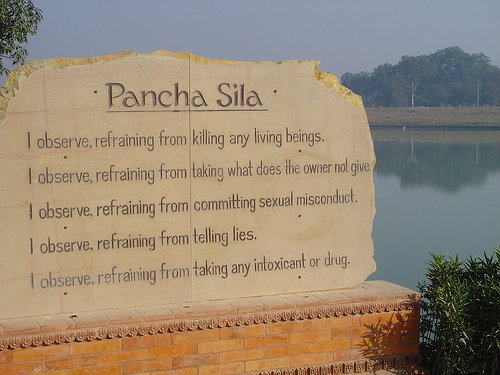
A virtuous person promises not to do these five things. Apart from this, Ashtasheel and Dashsheel are also famous in Buddhist Vinaya. Similar to the importance of the head in the body, in the Buddhist tradition, morality is important. Therefore, it is everyone’s responsibility to help make the society civilized by following these manners.
The Four Noble Truths of Buddhism
Buddha announced his religion not in Sanskrit language but in the vernacular of the time and avoided philosophical complexity and said briefly that ‘man is sad, suffering is not without cause. Its prevention is possible and there is a way. This is the Four Noble Truths of Buddhism, which are explained as follows.
First Aryasatya: The real suffering
Our life is usually full of dissatisfaction. This is the first truth. From birth to death there are many moments of happiness, but they are never permanent. Also, many moments are unpleasant. Birth is also sorrowful. Old age is also sad. The disease is also suffering. Death is also sorrowful. Meeting with unpleasant people is also sad. Separation from a loved one is also sad. It is also sad not to find the desired object when there is a desire.
Second Aryasatya: The Real cause of suffering
Our sorrows and momentary happiness do not arise for no reason. There can be many reasons and situations behind it. External factors (such as our society) can cause problems for us. But Buddha taught us to observe our own minds. Many turbulent emotions like hatred, anger, and greed push us towards self-destruction. Because of him, we are doing the same thing with our minds, words, and actions.
Third Aryasatya: The Real Cessation of Suffering
We don’t have to live with all these sufferings. If we find out the cause of these sorrows and root them out, their consequences will not arise. If we can remove the illusion that we have about the reality, there will be no problems. Buddha did not talk about removing one or two problems. Instead, he talked about changing our nature of creating new problems.
Fourth Aryasatya: The Real path of the mind
In order to get rid of our incomprehension and ignorance, we need to think about the obstacles in our path. For this: instead of rushing to get immediate happiness, let’s prepare a long-term plan. Let’s try to look at life as a whole without getting caught up in any small aspect of life. Let’s stop looking at what is convenient for us for the time being and think about the impact of our work on the rest of our lives and future generations. In that sermon, there are eight types of conduct, by following which human beings can destroy the cause of suffering.
The Eight fold Path
In summary,Modern civilization and Shakyamuni Buddha said to his followers through the above-mentioned sermon – have faith in my sermon, try to understand it with wisdom and try to put each sermon into life. Live a holy life and do meditation and samadhi regularly.
With the knowledge of the four noble truths, we can face the problems that come in our daily lives. You don’t have to be a Buddhist for that. It is not always possible to be just as we think. But because of that, we don’t have to be desperate or disappointed. The teaching of the Four Noble Truths covers everything we need to achieve true happiness and make our lives meaningful.
Book of Buddhist Ganthas (Tripitaka)
Tripitaka (Pali language: meaning: three baskets) is the main book of Buddhism. Which is accepted by all Buddhist sects (Mahayana, Theravada, Vajrayana, Mulasarvastivada, Navayana, etc.). This is the complete book of Buddhism in which the teachings of Lord Buddha are stored. This book is written in Pali language and has been translated into various languages. This book contains the discourses given by Lord Buddha from the time he attained enlightenment to Mahanirvana.
After attaining enlightenment in Bodh Gaya, Lord Buddha preached in various countries of the world including Nepal, India and Sri Lanka for 45 years. After Gautama Buddha’s Mahaparinirvana, Buddha’s words were collected in a sutra through various associations. This is called Tripitaka. Tripitaka is a collection of tri-meaning three bags- Abhidhamma Pitaka, Sutta Pitaka and Vinaya Pitaka.
Three months after Buddha’s death in 483 BC, under the patronage of King Ajatshatru of Magadha, under the leadership of monk Mahakashyapa Mahasthavira, a collection of Buddha’s discourses and Vinaya was compiled in collaboration with 500 arhat monks. It is first called ‘Sanghayana’. After 100 years, the second sanghayan was held in Vaishali under the patronage of King Kalasoka under the leadership of monk Revat Mahasthavir.
At the time of Emperor Ashoka, i.e. in 248 BC, the third sanghayana was held under the leadership of the monk Maugalliputtatissa Mahasthavira with the cooperation of one thousand monks and the fourth sanghayana was held during the reign of King Battagamini of Lankadwipa in 454 years after Buddha Mahaparinirvana.
Earlier Tripitaka was written on palm leaves. According to Gurushishya tradition, it was customary to protect Tripitaka Kanthastha. Acharya Bhikshu Amritananda Mahasthavira was the first to translate Tripitaka from Pali language into Nepali language. There are 84 thousand Skandhas and Shlokas in the Tripitaka.

Sutrapitaka:
Sutrapitaka is colloquially understood to be a collection of Dhamma (Dharma) or sermons given practically by Lord Buddha in some places in a formulaic way. It has 21 thousand Dharmaskandhas. This Sutrapitaka is also divided into five parts.
They are Digha Nikaya, Majjim Nikaya, Joint Nikaya, Anguttar Nikaya and Khuddak Nikaya. These also include 15 separate bodies, Khuddakapatha, Dhammapada, Udana, Ittivuttaka, Suttanipata, Vimanavattu, Petavattu, Theragatha, Therigatha, Jataka, Niddes, Patisambhidamagga, Apadana, Buddhavansa and Chariyapitaka.
Vinayapitaka:
The Vinayapitaka contains a collection of detailed sayings about the rules of Buddhist rule, rules to be followed by monks and nuns, code of conduct, upasampada rules, years, food, clothing, medicine and rules for conducting the Sangha. It has 21 thousand Dharmaskandhas. It consists of Mahavagga, Chulvagg, Pachitriya, Parajika, and Parivar Bhaga.
Abhidhammapitaka:
It is also divided into three parts. Under this Paramartha, there are Buddha words that are analyzed in a psychological manner in the form of Ati Sukshamatisuksha, basically about Chitta, Chaitsika, Rupa, and Nirvana. It contains 42 thousand Dharmaskandhas.
It is also divided into seven skandhas. These are as follows: Dhamma Sagani, Vibhaga, Kathavastu, Puggalpannati, Dhatukatha, Yamak and Patthan. Abhidharma Pitaka is also known as Buddhist philosophy.
Importance of Tripitaka:- Buddhist Tripitaka is very important from many points of view. In it, politics, economics, social system, crafts, music, clothing-jewelry, costumes, customs, and historical, geographical, commercial, etc. are presented in detail.
Three major Philosophy of Buddhism
Mahayana
The followers of Yash Mahayana Nikaya are also found to have translated the Buddha’s words and doctrines written in the Sanskrit language into the language of their respective countries. It seems that most of the countries around the world have been translated into the Tibetan language script and it has been spreading rapidly since the 9th century. The first principle of the Mahayana Nikaya is that the Modern civilization and Shakyamuni Buddha and various Bodhisattvas are deeply practiced, including supernatural Buddhas. The followers of the Yash Nikaya fully believe that every human being can become a Buddha and attain Nirban on the right path if they can save the living beings who are living their material lives in the ocean of Yash Bhavsagar by deeply practicing various Bodhisattvas. It is mandatory for every guru of the Mahayana Buddhism body to acquire knowledge of the 10 Paramitas by practicing the various Bodhisattva-related and Shanyuta paths. Those 10 parameters are as follows:-
Donation Paramita:-
One who gives charity whatever he asks for and becomes a charity, i.e. giving his best for the welfare of every living being is good deeds and donation paramita.
Seal Paramita:
According to Charya, seal paramita is very necessary for every human being to survive. The first part of this is to follow the rules of non-violence supreme religion.
Santi Paramita:-
Compassion does not kill all living beings, that is, for the sake of public welfare, even though all kinds of sufferings are inflicted on every human being, it is its first purpose and the path of good deeds to be tolerant and benevolent.
Birya Paramita:-
Having the power that cannot be killed by goddesses, humans, demons, etc., it means that it leads every person towards the path of courage and enthusiasm. However, saving all living beings by keeping one’s mind on the right path is the ultimate virtue.
Dhyan Paramita:-
Yoga, samadhi, meditation are all gone, that is, by concentrating the restless mind of man on the path of sanity, Dhyana Paramita is to save all the beings of the world through spiritual practice.
Prajna Paramita:-
This path is great for doing good deeds through seal, samadhi and prajnayukta conduct.
Ball Paramita: –
He has conquered everyone by revealing the truth. It is to follow force paramita by always doing good deeds for oneself and living beings.
Remedy Paramita:-
Along with spreading the knowledge of benevolence, always doing good deeds and working for the welfare of all beings is Remedy Paramita.
Pranidhana Paramita:-
To make everyone aware of good deeds for the welfare of living beings is to follow Pranidhana Paramita.
Jnana Paramita:
After getting the knowledge to be freed from the bondage of suffering in the world, spreading knowledge for the welfare of sentient beings is Jnana Paramita.
Theravada
Followers of Theravada Nikaya reverently worship Buddha as the first Guru. Because the Buddha preached in Pali language about the enlightenment he had received for 45 years, the followers of Yash Nikaya consider Pali language Buddhist texts as an important basis.
By protecting and enhancing these scriptures, seals, samadhi and prajna taught by the Buddha are practiced specifically for Nirvana. The followers of Yash Nikaya believe that those people can attain arhat if they follow those rare instructions of the Buddha without changing a single word of Buddha’s teachings based on Pali language and meditate deeply.
Bajrayana
The followers of Yash Bajrayana Nikaya also worship the supernatural Buddhas including the current Shakyamuni Gautama Buddha as the leader of public welfare. Mahabodhisattva Avalokitesvara is considered as a special faith. They consider various Bodhisattvas as their symbolic deities. That is why followers of Yash Nikaya have given special priority to idol worship. The followers of Yash Bajrayan Nikaya fully believe that if they can practice deeply with Mahabodhisattva Avalokitesvara and if they do good meditation, chanting, prajna, yoga, tantra-mantra and the path of Shanyuta, they can attain enlightenment in one lifetime.
Importance of Buddhist philosophy in Present society
The whole world has recognized the important role of Buddhist philosophy for the establishment of peace. For the development of human society, Buddhist philosophy has a significant role in inculcating mutual harmony, love, brotherhood and friendship. The basic teaching of Buddhist philosophy is peace and non-violence. Gautama Buddha taught peace, non-violence, friendship and compassion. In the Modern civilization and Shakyamuni Buddha philosophy, it is emphasized that every problem can be solved by the Panchasheela, Ashtasheela, Dashasheela and Arya Ashtangik path. Buddha said that Chatubrahavihara should follow and practice friendship, compassion, mudita and nonchalance. These sermons on how to get rid of the basic problems of human life, anger, malice, infatuation, hatred, greed, desire, fear and social anomalous, violent behavior are still very relevant for the human community and modern society today.
The relevance of Buddhist philosophy is increasing in the modern world. Conflicts and violence are rampant between different countries and groups due to arms competition and competition between different countries. Thus, mutual fighting and war between different nations is giving rise to huge loss of wealth, economic inequality, exploitation, discrimination, violence and terrorism. In such a situation, Modern civilization and Shakyamuni Buddha philosophy hates oppression and tyranny. Emphasizes the promotion of people’s right to live. Promotes good governance and leads a corruption-free society. It calls for an end to the armed gambit of war, which is carried out with the intention of capturing pride, arrogance and resources. It rejects war and violence. Because the Buddhist philosophy is the philosophy of peace, harmony, love, equality, development and prosperity.
Buddhist philosophy is believed to be based mainly on three principles: anism, anatism, and ephemerality. This philosophy teaches how to live a life of complete peace in the world. According to Buddha, every human being has the desire to become a Buddha. If every person has non-violence and peaceful mind, his family will be peaceful. Every person should know the light of his heart. The lamp of the extinguished mind should be lit. Thus, for every person in the world who is searching for peace, the Buddha’s philosophy is eternal and timeless.
The United Nations has approved the principle of Buddha’s Panchasheela and given it universal recognition. The modern world has accepted democracy, freedom, human rights, professional rights, equality, equality and human values in Buddhist philosophy. Peace, non-violence, human rights and democracy are complementary to each other. The right to peace is considered an integral part of international law. Human rights can be enjoyed only in peaceful conditions.
The Mahavani of the Buddhist philosophy, ‘Ahimsa paramo dharma’, expresses goodwill towards all beings. The name, work and philosophy of Gautama Buddha, the star of Asia and the harbinger of world peace, the synonym of unique peace, the name, work and Modern civilization and Shakyamuni Buddha are becoming more relevant in modern society. Buddhist philosophy emphasizes that peace, security, respect and self-respect should be progressed together in all human races.
The statements of various scientists and philosophers about Buddhist philosophy are very relevant. Scientist Albert Einstein expressed his deep belief about Buddhist philosophy and said, “If there is any philosophy compatible with modern science in today’s era, it is Buddhist philosophy.” The famous writer Bertand Roussel, expressing his deep faith in Buddhist philosophy, said that “Buddhism is not a religion of this or that race, but a scientific philosophy built for the welfare of the people of the whole world.”
In this way, the Buddhist philosophy is a philosophy established not only for the benefit and protection of all human beings and all creatures who want peace, but also for a particular race, language, religion and culture. Due to the very deep influence of Buddhist philosophy, there are many examples of the Kayan king maharajas leaving armed violence politics and starting politics of peace. As a vivid example of this, the case of Ashoka, the then powerful emperor of India, who first followed the path of violence and was later influenced by the philosophy of the Buddha, left the path of armed violence and was influenced by the philosophy of the Buddha and used all the resources of the state to propagate the Buddhist philosophy.

10 Key Points on the Importance of Buddhist Philosophy in Present Society
Peace and Non-violence:
Buddhist philosophy emphasizes peace and non-violence, teaching that every problem can be solved through principles such as Panchasheela, Ashtasheela, Dashasheela, and the Arya Ashtangik path.
Mutual Harmony and Compassion:
It promotes values like mutual harmony, love, brotherhood, and compassion, which are essential for the development of human society.
Relevance in Modern Conflicts:
In a world rife with conflicts and violence, Buddhist philosophy opposes oppression and tyranny, advocating for the right to live and promoting good governance and a corruption-free society.
Rejection of War:
It calls for an end to wars and armed conflicts, which are often driven by pride and resource competition, highlighting peace and prosperity instead.
Universal Principles:
Based on the principles of anism, anatism, and ephemerality, it guides people to live peaceful lives, with every individual aspiring to embody the qualities of a Buddha.
International Recognition:
The United Nations has recognized Buddha’s Panchasheela principles, aligning them with democracy, freedom, human rights, and equality.
Ahimsa Paramo Dharma:
The core teaching, “Ahimsa Paramo Dharma,” underscores non-violence as the highest virtue, promoting goodwill towards all beings.
Endorsement by Thinkers:
Renowned figures like Albert Einstein and Bertrand Russell have acknowledged the compatibility of Buddhist philosophy with modern science and its universal relevance.
Influence on Leadership:
Historical examples, such as Emperor Ashoka of India, illustrate how Buddhist philosophy has inspired leaders to abandon violence and adopt peaceful governance.
Eternal and Timeless:
For individuals seeking peace, Buddhist philosophy remains an eternal and timeless guide, fostering inner tranquility and societal harmony.
Robinson Crusoe Holidays offers a wide range of travel and tourism activities in Nepal, catering to various interests such as adventure, culture, spirituality, and relaxation. Here are some of the notable activities and tours they provide:
Multi-day Tour
Yoga Tour in Nepal Brief Insight
Yoga physical is a mental and spiritual practice or discipline which originated in ancient Nepal. Yoga is one of the six Astika (orthodox) schools of Hindu philosophical traditions. Yoga Tour in Nepal is a great experience in the Himalayas.
Outline Itinerary
- Day 1: Arrive in Kathmandu or your Destination
- Day 2: Visit Buddhanilkanth, Kapan and Bauddha Nath
- Day 3: Visit Namobuddha, Panauti and Bhaktapur
- Day 4: Visit Chovar, Pharping, Kirtipur and Swyambhu
- Day 5: Drive from Kathmandu to Pokhara and explore
- Day 6: Explore Pokhara then Drive from Pokhara to Kade and hike to Australian Camp
- Day 7: Trek from the Australian camp to Sarankot via Kaski Kot
- Day 8: Sarankot to Pokhara then back to Kathmandu
- Day 9: Final departure

